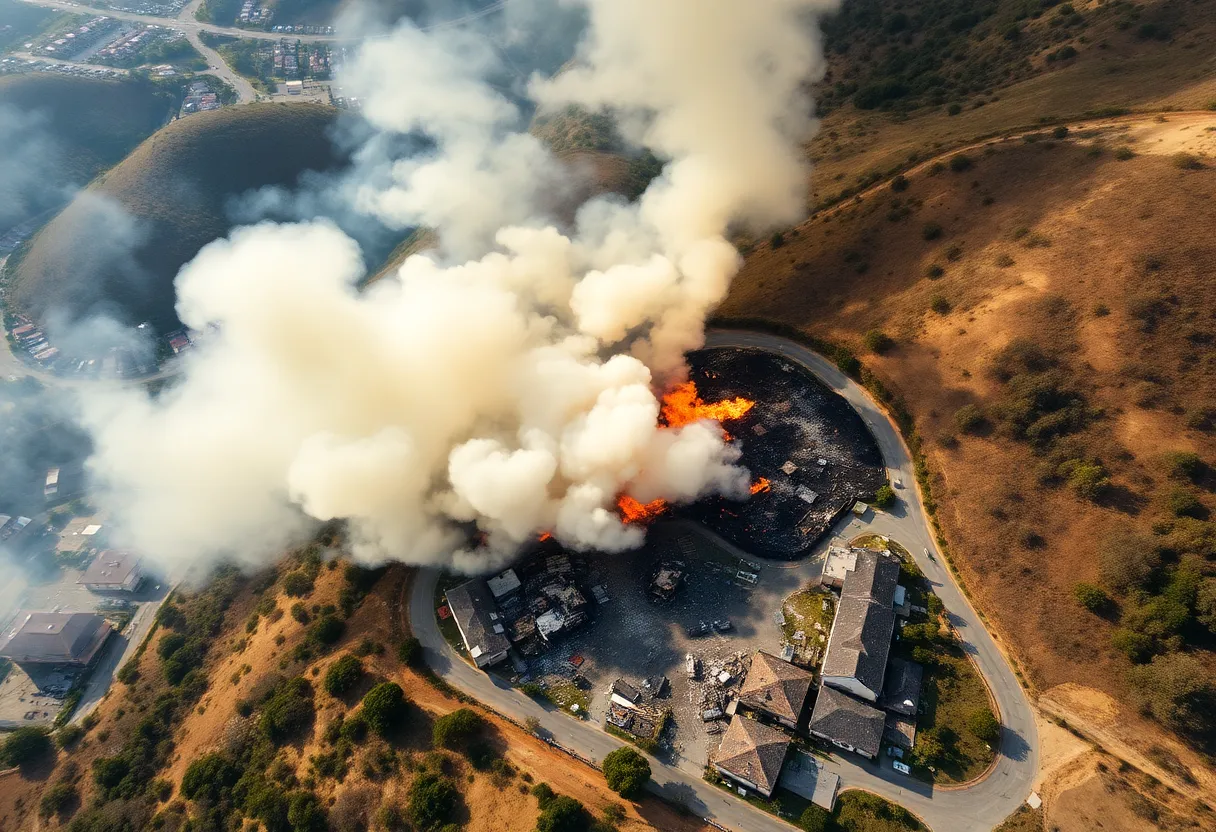News Summary
Catastrophic wildfires in Pacific Palisades raise urgent concerns over asbestos exposure as residents contemplate returning home.
Wildfires in Pacific Palisades Raise Alarming Concerns Over Asbestos Exposure
On January 7, 2025, the serene view of Pacific Palisades was suddenly marred by plumes of smoke rising ominously from nearby hills. This was the start of a catastrophic wildfire that ignited with terrifying speed, covering an initial area of 10 acres and rapidly escalating to a staggering 200 acres in under half an hour. Not long after, a second fire—dubbed the Eaton Fire—broke out, further compounding the devastation.
The wildfires were fueled by fierce winds, with gusts exceeding 80 miles per hour, exacerbating the flames and the destructive path they carved through the landscape. Over the course of three harrowing weeks, these blazes resulted in the tragic loss of 29 lives and the destruction of an astonishing 16,255 structures. The total area scorched reached over 37,000 acres, a grim reminder of the increasing frequency and intensity of such disasters.
Potential Asbestos Dangers Lurk in the Ashes
As residents begin contemplating the return to their homes, environmental experts are urgently advising caution. The remnants of the fiery devastation are not just ash; they could contain toxic substances, particularly asbestos. During the pre-1980 era, the use of asbestos in building materials was common, and the age of many of the destroyed buildings is still being assessed. Various historic structures have also succumbed to the flames, increasing the likelihood of exposing residents to hazardous materials.
Asbestos exposure is a known health risk and may significantly elevate the chances of developing mesothelioma, a rare, aggressive cancer primarily associated with asbestos. The situation is compounded by data indicating that the number of wildfires, along with their severity, has been on the rise, intensifying concerns about potential asbestos exposure within affected communities.
Research from the Environmental Protection Agency (EPA) revealed that as much as 20% of U.S. buildings prior to the 1980s contained asbestos. While undisturbed asbestos may not pose an immediate hazard, the dynamics of wildfires can have catastrophic effects—burning materials can send asbestos fibers swirling into the air, creating a substantial health threat.
History of Wildfires and Financial Implications
The financial burden of wildfires is staggering. Suppression costs reached over $3.1 billion in 2023 alone, reflecting a disturbing upward trend in wildfire management expenditures. Estimates suggest that the average annual total cost of wildfires could range from $394 billion to $893 billion. The persistent increase in wildfires is alarming; a study indicated that the Western and Eastern U.S. experienced twice as many fires in the wake of 2005 compared to the years before 1999. In the Great Plains, fire incidences quadrupled.
Wildfire seasons are now lasting seven months, a significant increase since the 1970s. As the number of wildfires rises, so does the risk of exposure to asbestos and other hazardous materials associated with burning debris. The U.S. is home to 876 natural asbestos deposits, and 142 of those have served as active mines, reinforcing the urgency of understanding the health implications of asbestos during wildfires.
Protective Measures and Risks
The lingering smoke and ash can travel significant distances, affecting areas well beyond the immediate fire site. Cleanup efforts can take considerable time, and the 2023 wildfire in Lahaina, Hawaii, serves as a stark example, where the aftermath saw over 34 tons of asbestos extracted from debris.
It is critical for those returning home to adhere to safety protocols, including wearing protective gear such as N95 masks to guard against inhalation of airborne toxins like asbestos. Officials recommend against disturbing ash left behind, as toxic residues may contain harmful chemicals linked to serious health risks, including cardiovascular disease.
As California grapples with the ongoing wildfire threat, the stakes have never been higher. The evolving landscape of these fires presents a daunting challenge for communities already burdened by the loss of property and life. Residents are urged to prioritize safety and stay informed as they navigate the treacherous terrain of wildfire recovery.
Deeper Dive: News & Info About This Topic
HERE Resources
Community Golf Event to Honor Liam Exley
The Fight Against Mesothelioma: A Glimmer of Hope in Cancer Treatment
Understanding the Complex Battle Against Mesothelioma
The Hidden Dangers of Asbestos: What You Need to Know
Widow’s Plea for Memories of Rugeley B Power Station Workers
The Ongoing Saga of Hotel O: A Demolition Delayed by Asbestos Concerns
Penobscot County’s $2 Million Asbestos Dilemma: A Community’s Burden and Opportunity
Asbestos Concerns Spark Urgent Responses in School Renovations
Asbestos Violations Shake Oregon’s Construction Sector
Asbestos Removal Begins at Hutchinson High School
Additional Resources
- Asbestos.com: Asbestos Warnings Issued in California Wildfires
- Wikipedia: Asbestos
- AP News: California Wildfires and Toxic Ash Health Risks
- Google Search: California Wildfires
- NY Times: California Fire Debris Concerns
- Google Scholar: Wildfire Health Impacts
- Reuters: Environmental Workers Race to Clear Toxic Debris from LA Fires
- Encyclopedia Britannica: Wildfire



















